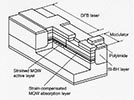Japan Semiconductor Innovation 50 (D-13 1990s)
Semiconductor Lasers for Optical Fiber Communications (NTT, KDDI, NEC, Fujitsu, Hitachi)
Tokyo Institute of Technologies (TIT) and NTT succeeded
in the world’s first room-temperature continuous oscillation of InGaAsP/InP
lasers in 1976. NEC, Fujitsu, Hitachi and several other Japanese companies
followed this achievement and took technical leadership world-wide, by improving
the performance of the lasers by various key inventions and development
of modified laser structures, such as Distributed-Bragg-Reflector (DBR)
lasers, Distributed Feedback-Multiple-Quantum well (DFB-MQW) lasers, and
Modulator-Integrated-DFB (MI-DFB) lasers. Crystal growth and fabrication
technologies for volume production of these lasers were also established.
High capacity optical fiber communication systems were realized by using
these lasers, such as Japan end-to-end long-haul trunk optical fiber cable
routes in 1985, and the transpacific optical fiber submarine cable system
in 1989.
These lasers have played an important role in explosive expansion of high
speed, long distance, high capacity communication systems in the world.
Structure of MI-DFB laser |
 |
| (Fujitsu Sci. Tech. J., 35, p.101 (1999) |
Remarks
To main gallery (Discrete Device 1980s)
Database on Noteworthy Contributions
for Science and Technology (Japan)
1) Dynamic
Single Mode Lasers and Integrated Lasers ~ Basic Research for Ultra-high
Speed and Long Distance Optical Fiber Communications ~
2) Development
of optical semiconductor devices for long-distance and high-capacity optical
communications